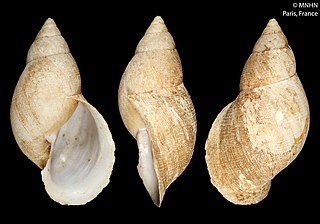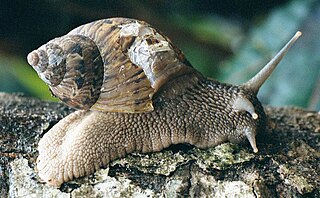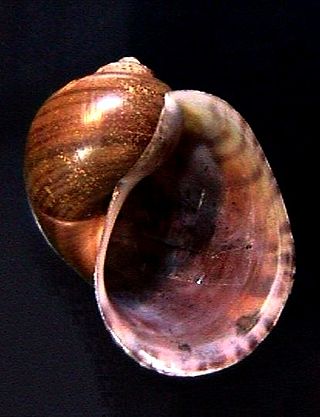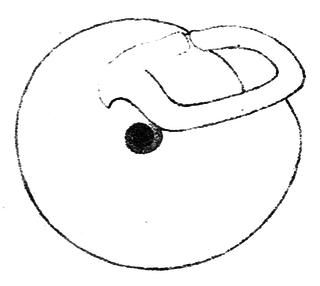
Limax maximus, known by the common names great grey slug and leopard slug, is a species of slug in the family Limacidae, the keeled slugs. It is among the largest keeled slugs, Limax cinereoniger being the largest.

Cornu aspersum, known by the common name garden snail, is a species of land snail in the family Helicidae, which includes some of the most familiar land snails. Of all terrestrial molluscs, this species may well be the most widely known. It was classified under the name Helix aspersa for over two centuries, but the prevailing classification now places it in the genus Cornu.

Bulimulidae is a taxonomic family of medium-sized to large, air-breathing, tropical and sub-tropical land snails, terrestrial pulmonate gastropod molluscs in the superfamily Orthalicoidea.

Bulimulus is a genus of small to medium-sized tropical or sub-tropical, air-breathing land snails, pulmonate gastropod mollusks in the subfamily Bulimulinae within the family Bulimulidae.

Orthalicidae are a family of tropical air-breathing land snails, terrestrial pulmonate gastropod mollusks are classified in the subfamily Orthalicoidea of the order Stylommatophora.

Bradybaena similaris, the Asian trampsnail, is a species of small, invasive land snail. It is a pulmonate gastropod terrestrial mollusc in the family Bradybaenidae. It earned the common name based on its origins, and its habit of roosting on freight containers. This habit means that this may be one of the most broadly-distributed species of terrestrial snail in the world. Bradybaena similaris is the type species of the genus Bradybaena.

Subulina octona is a species of small, tropical, air-breathing land snail, a terrestrial pulmonate gastropod mollusk in the family Achatinidae.

Pomacea haustrum, common name the titan applesnail, is a species of large freshwater snail with an operculum, an aquatic gastropod mollusk in the family Ampullariidae, the applesnails.

Biomphalaria glabrata is a species of air-breathing freshwater snail, an aquatic pulmonate gastropod mollusk in the family Planorbidae, the ram's horn snails.
Angiostrongylus costaricensis is a species of parasitic nematode and is the causative agent of abdominal angiostrongyliasis in humans. It occurs in Latin America and the Caribbean.

Biomphalaria tenagophila is a species of air-breathing freshwater snail, an aquatic pulmonate gastropod mollusk in the family Planorbidae, the ram's horn snails.

Hyperaulax ridleyi is a species of tropical air-breathing land snail, a terrestrial pulmonate gastropod mollusk in the family Odontostomidae.

Placostylus ambagiosus is a species of flax snail, a large air-breathing land snail, a terrestrial pulmonate gastropod mollusc in the family Bothriembryontidae.
Laevapex vazi is a species of small, freshwater, air-breathing limpet, an aquatic pulmonate gastropod mollusc or micromollusc in the family Planorbidae, the ram's horn snails and their allies.

Drymaeus tripictus is a species of air-breathing land snail, a terrestrial pulmonate gastropod mollusc in the family Bulimulidae.

Bulimulus bonariensis, the ghost Bulimulus, is a species of terrestrial snail in the family Bulimulidae.















